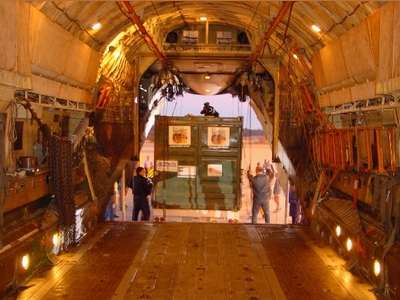Why Did IL-76 Cargo Doors Pop Open At 33,000 Ft.?
 The death toll continues to rise in a scene that
has become terribly familiar in Africa - another aircraft
disaster.
The death toll continues to rise in a scene that
has become terribly familiar in Africa - another aircraft
disaster.
In this case, a Russian-made IL-76 cargo plane (file photo
during airdrop ops, right) with as many as 300 Congolese police
officers, soldiers and members of their families on board suffered
a major in-flight catastrophe; the rear cargo doors opened at
33,000, sucking dozens - perhaps hundreds - of people out of the
cabin. They fell more than six miles to their deaths.
Continued Confusion
Different officials in the Democratic Republic of Congo tell
different stories about what happened to the Ukranian military,
which had been chartered by the Congolese military to fly soldiers,
police officers and their families from Kinshasa to Lubumbashi. At
the Kinshasa Airport, where the plane landed after the emergency,
two officials told the AP 129 people had plunged to their deaths in
the tragedy. Others say the number is 160. Still others believe
there were 350 people crammed into the Il-76's cargo bay, along
with at least one vehicle and other equipment. If that's true, more
than 200 people are now missing and presumed dead.

"We have seen this type of aircraft take more than 300 people on
board during troop flights," said a Kinshasa airport source in an
interview with the Australian Broadcasting Company.
The passenger list is incomplete. Authorities in the DRC may
never know who was actually on board the aircraft. But slowly -
very slowly - details of the horror six miles up are starting to
come to light.
Survivor Horror Stories
Approximately 35 minutes after the Ilyushin left Kinshasa, the
aircraft had climbed to 33,000 feet. But there was a problem. One
passenger, identified by Reuters as Police Sergeant Kabmba Kashala,
said the IL-76 had apparently taken off with the massive rear cargo
doors improperly fastened. He said there were three attempts to
fasten the doors inflight, to no avail. The doors sprang open and
both passengers and cargo were literally sucked out of the
aircraft.
One anonymous survivor told the French news agency AFP, "There
were no seats, only a few folding chairs along the cabin walls.
People were crammed onto benches and on the floor. When the door
came off, the plane tipped to the right then to the left, and many
people fell towards the hole." Another, Police Officer Mambaza
said, "When the back door opened, I fell down and lots of boxes
covered me," he told Associated Press news agency from a military
hospital in the Congolese capital Kinshasa. "Lots of my colleagues
were sucked out by the wind. I don't know how many, because I
fainted." Mambaza told the AP he estimated, of the 350 people on
board, no more than 100 had survived.

Mambaza's wife, Bebe, was also on the ill-fated IL-76. "Us
women, we had a little bit of luck because we had been placed close
to the cabin, therefore far from the door, but we sustained some
damages." She said the shock of the disaster caused two pregnant
women on board to miscarry.
Those who remained on board the depressurized aircraft literally
grabbed anything they could to save their own lives. "It was by
clinging with my arms and legs to the netting that I managed not to
be sucked out like the others," one survivor told the AFP.
Two police officers said they survived by grabbing onto a truck
that had been strapped down inside the cargo area. "The truck
served as a barrier for most of the survivors, it prevented them
from falling out of the gaping hole."
Sgt. Kashala remembered the exact moment the cargo doors burst
open. "I was just next to the door and I had the chance to grab
onto a ladder just before the... door let loose," he said.
The crew of the chartered IL-76 was reportedly from Russia. They
were able to return to Kanshasa and land. Congolese officials say
the investigation is underway and helicopters are combing the area
for bodies.
 ANN's Daily Aero-Term (12.19.25): Ultrahigh Frequency (UHF)
ANN's Daily Aero-Term (12.19.25): Ultrahigh Frequency (UHF) NTSB Prelim: Cirrus Design Corp SR22T
NTSB Prelim: Cirrus Design Corp SR22T Classic Aero-TV: The Red Tail Project--Carrying the Torch of the Tuskegee Airmen
Classic Aero-TV: The Red Tail Project--Carrying the Torch of the Tuskegee Airmen Aero-News: Quote of the Day (12.19.25)
Aero-News: Quote of the Day (12.19.25) Airborne 12.17.25: Skydiver Hooks Tail, Cooper Rotax Mount, NTSB v NDAA
Airborne 12.17.25: Skydiver Hooks Tail, Cooper Rotax Mount, NTSB v NDAA





